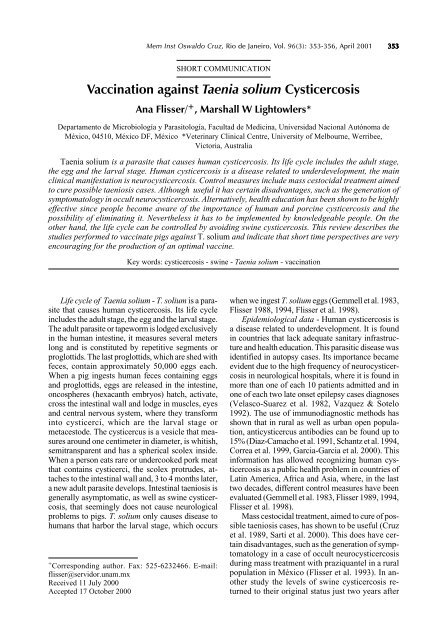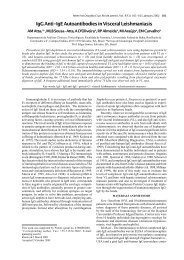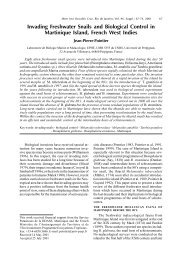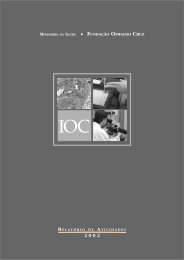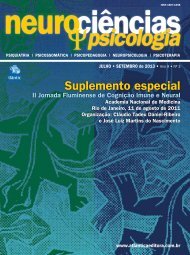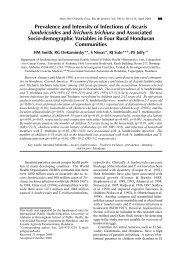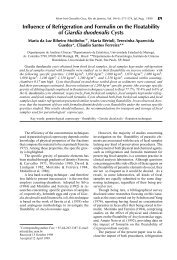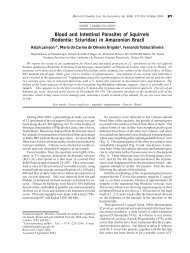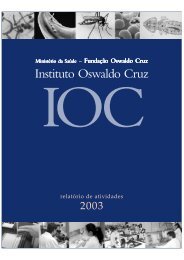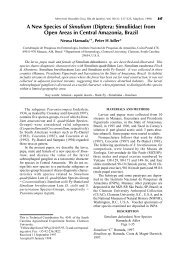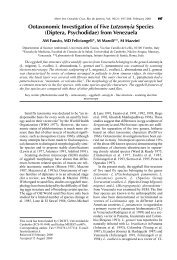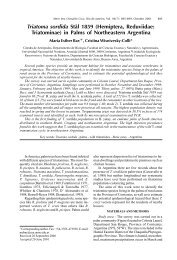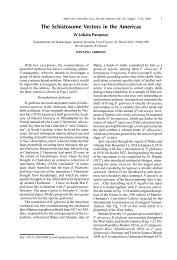Vaccination against Taenia solium Cysticercosis - SciELO
Vaccination against Taenia solium Cysticercosis - SciELO
Vaccination against Taenia solium Cysticercosis - SciELO
- No tags were found...
Create successful ePaper yourself
Turn your PDF publications into a flip-book with our unique Google optimized e-Paper software.
Mem Inst Oswaldo Cruz, Rio de Janeiro, Vol. 96(3): 353-356, April 2001353SHORT COMMUNICATION<strong>Vaccination</strong> <strong>against</strong> <strong>Taenia</strong> <strong>solium</strong> <strong>Cysticercosis</strong>Ana Flisser/ + , Marshall W Lightowlers*Departamento de Microbiología y Parasitología, Facultad de Medicina, Universidad Nacional Autónoma deMéxico, 04510, México DF, México *Veterinary Clinical Centre, University of Melbourne, Werribee,Victoria, Australia<strong>Taenia</strong> <strong>solium</strong> is a parasite that causes human cysticercosis. Its life cycle includes the adult stage,the egg and the larval stage. Human cysticercosis is a disease related to underdevelopment, the mainclinical manifestation is neurocysticercosis. Control measures include mass cestocidal treatment aimedto cure possible taeniosis cases. Although useful it has certain disadvantages, such as the generation ofsymptomatology in occult neurocysticercosis. Alternatively, health education has been shown to be highlyeffective since people become aware of the importance of human and porcine cysticercosis and thepossibility of eliminating it. Nevertheless it has to be implemented by knowledgeable people. On theother hand, the life cycle can be controlled by avoiding swine cysticercosis. This review describes thestudies performed to vaccinate pigs <strong>against</strong> T. <strong>solium</strong> and indicate that short time perspectives are veryencouraging for the production of an optimal vaccine.Key words: cysticercosis - swine - <strong>Taenia</strong> <strong>solium</strong> - vaccinationLife cycle of <strong>Taenia</strong> <strong>solium</strong> - T. <strong>solium</strong> is a parasitethat causes human cysticercosis. Its life cycleincludes the adult stage, the egg and the larval stage.The adult parasite or tapeworm is lodged exclusivelyin the human intestine, it measures several meterslong and is constituted by repetitive segments orproglottids. The last proglottids, which are shed withfeces, contain approximately 50,000 eggs each.When a pig ingests human feces containing eggsand proglottids, eggs are released in the intestine,oncospheres (hexacanth embryos) hatch, activate,cross the intestinal wall and lodge in muscles, eyesand central nervous system, where they transforminto cysticerci, which are the larval stage ormetacestode. The cysticercus is a vesicle that measuresaround one centimeter in diameter, is whitish,semitransparent and has a spherical scolex inside.When a person eats rare or undercooked pork meatthat contains cysticerci, the scolex protrudes, attachesto the intestinal wall and, 3 to 4 months later,a new adult parasite develops. Intestinal taeniosis isgenerally asymptomatic, as well as swine cysticercosis,that seemingly does not cause neurologicalproblems to pigs. T. <strong>solium</strong> only causes disease tohumans that harbor the larval stage, which occurs+ Corresponding author. Fax: 525-6232466. E-mail:flisser@servidor.unam.mxReceived 11 July 2000Accepted 17 October 2000when we ingest T. <strong>solium</strong> eggs (Gemmell et al. 1983,Flisser 1988, 1994, Flisser et al. 1998).Epidemiological data - Human cysticercosis isa disease related to underdevelopment. It is foundin countries that lack adequate sanitary infrastructureand health education. This parasitic disease wasidentified in autopsy cases. Its importance becameevident due to the high frequency of neurocysticercosisin neurological hospitals, where it is found inmore than one of each 10 patients admitted and inone of each two late onset epilepsy cases diagnoses(Velasco-Suarez et al. 1982, Vazquez & Sotelo1992). The use of immunodiagnostic methods hasshown that in rural as well as urban open population,anticysticercus antibodies can be found up to15% (Diaz-Camacho et al. 1991, Schantz et al. 1994,Correa et al. 1999, Garcia-Garcia et al. 2000). Thisinformation has allowed recognizing human cysticercosisas a public health problem in countries ofLatin America, Africa and Asia, where, in the lasttwo decades, different control measures have beenevaluated (Gemmell et al. 1983, Flisser 1989, 1994,Flisser et al. 1998).Mass cestocidal treatment, aimed to cure of possibletaeniosis cases, has shown to be useful (Cruzet al. 1989, Sarti et al. 2000). This does have certaindisadvantages, such as the generation of symptomatologyin a case of occult neurocysticercosisduring mass treatment with praziquantel in a ruralpopulation in México (Flisser et al. 1993). In anotherstudy the levels of swine cysticercosis returnedto their original status just two years after
354 <strong>Cysticercosis</strong> Vaccine • A Flisser, MW Lightowlersmass treatment in a rural area in Ecuador (J Proaño,pers. commun.), due probably to the fact that nocontrol was implemented to eliminate the sourceof tapeworm infection of human beings, that is pigswith cysticercosis. For these reasons it is consideredmore adequate to provide treatment to eliminatetapeworms only to those people previouslyidentified or that have a high risk of being carriers.Health education is highly effective as it wasshown in the community intervened that becameaware of the importance of human and porcine cysticercosisand the possibility of eliminating it (Sartiet al. 1997). Nevertheless health education must beprovided by exprofesso well trained personnel andis still more effective if it is associated to identificationand treatment of tapeworm carriers. Furthermore,it is necessary to elaborate and implementhealth education programs, which must be associatedto improvement of sanitary infrastructure, elementsthat eliminated the presence of T. <strong>solium</strong> inEurope at the beginning of last century.<strong>Vaccination</strong> - An alternative approach for thecontrol of taeniosis and cysticercosis due to T.<strong>solium</strong> is the use of vaccines in pigs. Furthermore,an effective and safe vaccine <strong>against</strong> swine cysticercosisis mandatory for the evaluation of similarvaccines for human use.Since there are many <strong>Taenia</strong> species that infectmammals, there are many studies in rodents, ovineand bovines that demonstrate that it is possible toacquire protection <strong>against</strong> cysticercosis by vaccination.In most studies crude antigens have been usedwhich were obtained from oncospheres, cysticercior tapeworms (Flisser et al. 1979, Lightowlers 1994).These studies have been relatively easy to performsince the different stages of the parasite (cysticerciand adults) develop in animals, thus it is feasible tomaintain the infected hosts to be used according toexperimental needs. Various degrees of protectionhave been reported; it has been demonstrated thatliving oncospheres and oncospheral antigens are themost effective (Flisser et al. 1979, Lightowlers1994). Recently the use of recombinant proteins andDNA as vaccines <strong>against</strong> rodent, ovine and bovinecysticercosis has been used with high degrees ofimmunity (Johnson et al. 1989, Harrison et al. 1996,Lightowlers et al. 1996, Rosas et al. 1998, Cruz-Revilla et al. 2000).In order to perform vaccination studies <strong>against</strong>T. <strong>solium</strong> there must be enough eggs accessible tochallenge infected animals, eggs that can only beobtained from human beings with taeniosis. Probablythis has been the greatest difficulty for performingsuch studies and the reason why there areso few publications in this respect. Recently an experimentalmodel was established in chinchillasthat allowed the reproduction of the complete lifecycle of the parasite, since one chinchilla infectedwith cysticerci produced a gravid tapeworm, withwhich a pig was infected, developing 14 cysticerci(Maravilla et al. 1998). If this system can be reproducedreliably, an alternative for supply of T.<strong>solium</strong> eggs can be achieved.In spite of the difficulty for obtaining T. <strong>solium</strong>eggs, there are published data that allow evaluatingthe usefulness of vaccination in pigs. Results obtainedin various experiments performed in order todefine if it is possible to protect swine <strong>against</strong> anoral challenge with T. <strong>solium</strong> eggs are summarizedin the Table. As it can bee seen, different antigenshave been used to immunize. In the first study performed,Herbert and Oberg (1974) used two dosesof T. <strong>solium</strong> eggs, in the remaining studies, antigenswere obtained as crude extracts from whole T. <strong>solium</strong>cysticerci (Molinari et al. 1983a), the scolices or theirchromatographic peaks (Kumar et al. 1987,Nascimento et al. 1995), T. crassiceps vesicular fluidor the bands corresponding to proteins of 56, 66,and 74 kDa from this fluid (Manoutcharian et al.1996), secretions and excretions or crude extractsfrom T. <strong>solium</strong> oncospheres (Phatak & Gaur 1990,Plancarte et al. 1999) and also T. ovis recombinantantigens (Plancarte et al. 1999). The number of eggsused for challenge of vaccinated or control animalsfluctuated between 4,000 and 25,000. The last twocolumns of the Table show the results obtained, organizedas average number of cysticerci establishedand percentage of establishment, calculated from thenumber of eggs used for challenge and the numberof cysticerci counted at necropsy. Except for theresults obtained by the groups of Nascimento andof Manoutcharian, establishment in non-vaccinatedpigs ranged between 0.7% and 3.4% and in vaccinatedgroups between 0.02% and 0.2%. A reviewof the literature yielded 1% of establishment in 255non-vaccinated different mammal hosts infectedwith different species of <strong>Taenia</strong> and 0.3% in 927vaccinated hosts (Flisser et al. 1979). The valuesshown in the Table are in the same range for nonvaccinatedhosts but are lower in immunized hostsindicating that the efficacy of implantation of parasitesin natural conditions is similar regardless hostand <strong>Taenia</strong> species, in contrast implantation of cysticerciis lower in vaccinated pigs suggesting thatswine immunization is quite successful. These dataare of great importance because they also show thatreproducibility of natural conditions of the infectionis adequate, and thus, experimental data arevalid. The work of Manoutcharian and colleagues(1996) yielded the highest protection; neverthelessthe number of cysticerci established in control animalswas the lowest in comparison with the otherstudies, while the work of Nascimento and colleagues(1995) had very high numbers of cysticerciestablished in non-vaccinated and also in immunizedhosts.
Mem Inst Oswaldo Cruz, Rio de Janeiro, Vol. 96(3), April 2001355TABLEEstablishment of <strong>Taenia</strong> <strong>solium</strong> cysticerci in control pigs and in swine vaccinated with different antigensAuthor/Year Vaccine Pigs Eggs Average %cysticerci establishmentHerbert/1974 None 3 4,300 146 3.42 doses eggs 4 3,900 5 0.1Molinari/1983 None 5 8,400 79 0.9Crude extract 6 8,400 12 0.1Nascimento/1995 None 4 10,000 926 9.3Scolex extract 7 10,000 324 3.2Manoutcharian/1996 None 6 10,000 5 0.05Vesicular fluid 7 10,000 2.5 0.02Gel bands 6 10,000 0.2 0.002Kumar/1987 None 4 15,000 250 1.7Seph. 2nd peak 4 15,000 56 0.4Seph. 1st peak 4 15,000 6 0.04Pathak/1990 None 8 15,000 369 2.5Oncos. E/S 8 15,000 19 0.1Plancarte/1999 None 5 25,000 172 0.7Recomb. T.ov. 5 25,000 39 0.2Oncos. extract 5 25,000 16 0.06Molinari and colleagues (1983b) informed thatcysticerci of pigs with natural infections were infiltratedby eosinophils and had various degrees ofnecrosis after the pigs were vaccinated with a crudeextract of T. <strong>solium</strong> cysticerci. A study performedin rural conditions with these same extract showedthat 12 months after vaccinating thousands of pigsin several communities of an endemic area inMexico, no pig was found with cysticercosis inhundreds of animals reviewed (Molinari et al.1993). Even though the results are very encouraging,this vaccine corresponds to a crude extract,thus it has multiple components, some of whichmight have non-desirable effects, as has beenshown with some antigens that facilitate the establishmentof the infection, since, for example theefficiency of protection reported for the 220-205kDa antigen obtained from T. crassiceps was of-49.7% (Valdez et al. 1994).Sciutto and colleagues (1990) demonstratedcross protection between T. <strong>solium</strong> and T. crassiceps,nevertheless the model of T. crassiceps, which isestablished in rodents by intraperitoneal injectionof cysticerci, does not reflect the sort of protectionthat has to be induced <strong>against</strong> the ingestion of eggsand the passage of embryos through the intestinalwall and the circulation, as well as the establishmentof larvae in target tissues. In T. <strong>solium</strong> cysticercosis,this same research group demonstratedrecently that by vaccinating pigs with recombinantpeptides in natural conditions, in a rural communityin the state of Puebla, it was possible to reducegreatly this parasitic disease (pers. commun.).The studies described above indicate that swinecysticercosis is feasible to be controlled by vaccinationand that short time perspectives are very encouragingfor the production of an optimal vaccine.Especially useful are recombinant proteins, since thetrial performed showed high efficacy and the use ofthis type of proteins solve the problem of havingunknown components in the mixture and the needof having cysticerci for the production of the vaccine.Probably the combination of targeted treatmentof tapeworm carriers and vaccination of pigs, mainlyin rural habitats, will enable to eradicate <strong>Taenia</strong><strong>solium</strong>, and with it human neurocys-ticercosis.REFERENCESCorrea D, Sarti E, Tapia-Romero T, Rico R, Alcántara-Anguiano I, Salgado A, Valdez L, Flisser A 1999.Antigens and antibodies in sera from human casesof epilepsy or taeniasis from an area of Mexico where<strong>Taenia</strong> <strong>solium</strong> cysticercosis is endemic. Ann TropMed Parasitol 93: 69-74.Cruz ME, Davis A, Dixon H, Pawlowski ZS, Proaño J1989. Operational studies on the control of <strong>Taenia</strong><strong>solium</strong> taeniasis/cysticercosis in Ecuador. Bull WHO67: 401-407.Cruz-Revilla C, Rosas G, Fragoso G, López-Casillas F,Toledo A, Larralde C, Sciutto E 2000. <strong>Taenia</strong>crassiceps cysticercosis: protective effect and immuneresponse elicited by DNA immunization. JParasitol 86: 67-74.
356 <strong>Cysticercosis</strong> Vaccine • A Flisser, MW LightowlersDiaz-Camacho S, Candil A, Suate V, Zazueta ML, FelixM, Lozano R, Willms K 1991. Epidemiologicalstudy and control of <strong>Taenia</strong> <strong>solium</strong> infections withpraziquantel in a rural village of Mexico. Am J TropMed Hyg 45: 522-531.Flisser A 1988. Neurocysticercosis in Mexico. ParasitolToday 4: 131-137.Flisser A 1994. <strong>Taenia</strong>sis and cysticercosis due to <strong>Taenia</strong><strong>solium</strong>. In Tsieh Sun, Progress in Clinical Parasitology,Vol. 4, CRC Press Inc, Boca Raton, Florida,p. 77-116.Flisser A, Madrazo I, Delgado H 1998. Cisticercosishumana, El Manual Moderno, México DF, 176 pp.Flisser A, Madrazo I, Plancarte A, Schantz PM, Allan J,Craig P, Sarti E 1993. Neurological symptoms inoccult neurocysticercosis after a single taeniacidaldose of praziquantel. Lancet 342: 748.Flisser A, Pérez-Montfort R, Larralde C 1979. The immunologyof human and animal cysticercosis. A review.Bull WHO 57:839-856.García-García DL, Torres M, Correa D, Flisser A, Sosa-Lechuga A, Velasco O, Meza-Lucas A, Plancarte A,Avila G, Tapia R, Aguilar L, Mandujano A, AlcántaraI, Morales Z, Salcedo A, Manon ML, Valdespino JL2000. Prevalence and risk of cysticercosis and taeniasisin an urban population of soldiers and their relatives.Am J Trop Med Hyg 61: 386-389.Gemmell M, Matyas Z, Pawlowski Z, Soulsby EJL,Larralde C, Nelson GS, Rosicky B 1983. Guidelinesfor Surveillance, Prevention and Control of <strong>Taenia</strong>sis/<strong>Cysticercosis</strong>,VPH/83.49, WHO, 207 pp.Harrison GBL, Heath DD, Dempster RP, Gaucci C,Newton SE, Cameron WG, Lawrence SB,Lightowlers MW, Rickard MD 1996. Identificationand cDNA cloning of two novel low molecularweight host-protective antigens from <strong>Taenia</strong> ovisoncospheres. Int J Parasitol 26: 195-204.Herbert IV, Oberg C 1974. <strong>Cysticercosis</strong> in pigs due toinfection with <strong>Taenia</strong> <strong>solium</strong> Linnaeus, 1758. In EJLSoulsby, Parasitic Zoonosis, Academic Press, NewYork, p. 199-211.Johnson KS, Harrison GBL, Lightowlers MW, O’HoyKL, Dempster RP, Lawrence SB, Vinton JG, HeathDD, Rickard MD 1989. <strong>Vaccination</strong> <strong>against</strong> ovinecysticercosis using a defined recombinant antigen.Nature 338: 585-587.Kumar D, Gaur SNS, Pathak ML 1987. Immunization ofpigs <strong>against</strong> the cysticercus of <strong>Taenia</strong> <strong>solium</strong> usingfractionated first and second peaks of cysticercuscellulosae scolex antigen. Indian J Anim Sci 57: 932-935.Lightowlers MW 1994. <strong>Vaccination</strong> <strong>against</strong> animal parasites.Vet Parasitol 54: 177-204.Lightowlers MW, Rolfe R, Gaucci CG 1996. <strong>Taenia</strong>saginata: vaccination <strong>against</strong> cysticercosis in cattlewith recombinant oncosphere antigens. ExpParasitol 84: 330-338.Manoutcharian K, Rosas G, Hernández M, Fragoso G,Aluja A, Villalobos N, Rodarte LF, Sciutto E 1996.<strong>Cysticercosis</strong>: identification and cloning of protectiverecombinant antigens. J Parasitol 82: 250-254.Maravilla P, Avila G, Cabrera V, Aguilar L, Flisser A1998. Comparative development of <strong>Taenia</strong> <strong>solium</strong>in experimental models. J Parasitol 84: 882-886.Molinari JL, Meza R, Suarez B, Palacios S, Tato P,Retana A 1983a. <strong>Taenia</strong> <strong>solium</strong>: immunity in thehogs to the cysticercus. Exp Parasitol 55: 340-357.Molinari JL, Meza R, Tato P 1983b. <strong>Taenia</strong> <strong>solium</strong>: cellreactions to the larva (Cysticercus cellulosae) in naturallyparasitized, immunized hogs. Exp Parasitol 56:327-338.Molinari JL, Soto R, Tato P, Rodriguez D, Retana A,Sepulveda J, Palet A 1993. Immunization <strong>against</strong>porcine cysticercosis in an endemic area in Mexico:a field and laboratory study. Am J Trop Med Hyg49: 502-512.Nascimento E, Costa JO, Guimaraca MP, Tavares CAP1995. Effective immune protection of pigs <strong>against</strong> cysticercosis.Vet Immunol Immunoparasitol 45: 127-137.Pathak KML, Gaur SNS 1990. Immunization of pigswith culture antigens of <strong>Taenia</strong> <strong>solium</strong>. Vet Parasitol34: 353-356.Plancarte A, Flisser A, Gaucci CG, Lightowlers MW1999. <strong>Vaccination</strong> <strong>against</strong> <strong>Taenia</strong> <strong>solium</strong> cysticercosisin pigs using native and recombinant oncosphereantigens. Intl J Parasitol 29: 643-647.Rosas G, Cruz-Revilla G, Fragoso G, López-Casillas F,Pérez A, Bonilla MA, Rosales R, Sciutto E 1998.<strong>Taenia</strong> crassiceps cysticercosis: humoral immuneresponse and protection elicited by DNA immunization.J Parasitol 84: 516-523.Sarti E, Flisser A, Schantz PM, Gleizer M, Loya M,Plancarte A, Avila G, Allan J, Craig P, BronfmanM, Wijeyaratne P 1997. Development and evaluationof a health education intervention <strong>against</strong> <strong>Taenia</strong><strong>solium</strong> in a rural community in Mexico. Am JTrop Med Hyg 56: 127-132.Sarti E, Schantz PM, Avila G, Ambrosio J, Medina-Santillán R, Flisser A 2000. Mass treatment <strong>against</strong>human taeniasis for the control of cysticercosis: apopulation-based intervention study. Trans R SocTrop Med Hyg 94: 85-89.Schantz PM, Sarti E, Plancarte A, Wilson M, CrialesJL, Roberts J, Flisser A 1994. Community-basedinvestigations of cysticercosis due to <strong>Taenia</strong> <strong>solium</strong>:comparison of serological screening tests and clinicalfindings in two populations in Mexico. Clin InfectDis 186: 879-885.Sciutto E, Fragoso G, Trueba L, Lemus D, Montoya RM,Diaz ML, Govezensky T, Lomeli C, Tapia H,Larralde C 1990. <strong>Cysticercosis</strong> vaccine: cross protectingimmunity with T. <strong>solium</strong> antigens <strong>against</strong>experimental murine T. crassiceps cysticercosis.Parasite Immunol 12: 687-696.Valdez F, Hernández M, Govezensky T, Fragoso G,Sciutto E 1994. Immunization <strong>against</strong> <strong>Taenia</strong>crassiceps cysticercosis: identification of the mostpromising antigens in the induction of protectiveimmunity. J Parasitol 80: 931-936.Vazquez V, Sotelo J 1992. The course of seizures aftertreatment of cerebral cysticercosis. NEJM 327: 696-701.Velasco-Suarez M, Bravo MA, Quirasco F 1982. Humancysticercosis: medical-social implications andeconomic impact. In A Flisser, K Willms, JPLaclette, C Larralde, C Ridaura, F Beltran (eds), <strong>Cysticercosis</strong>.Present State of Knowledge and Perspectives,Academic Press, New York, p. 47-51.


